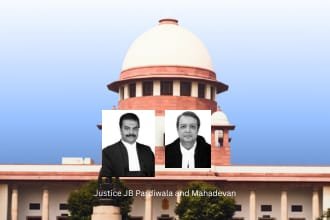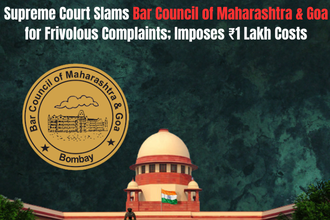In a powerful rebuttal to Vice President Jagdeep Dhankhar’s recent comments about the Supreme Court’s use of Article 142 of the Constitution, Senior Advocate and Supreme Court Bar Association (SCBA) President Kapil Sibal has emphasized that labeling Article 142 as a “nuclear missile” against democratic forces is not only incorrect but also deeply problematic. The remark, which was made in the context of a recent Supreme Court judgment concerning the role of the President and the Governor in the legislative process, has sparked a fresh debate on judicial overreach, constitutional interpretation, and the independence of the judiciary.
This article explores the origins and significance of Article 142 of the Indian Constitution, analyzes the recent controversy, and underscores why this provision remains a cornerstone of the Supreme Court’s power to do “complete justice”.
What Is Article 142 of the Indian Constitution?
Article 142(1) of the Constitution of India reads:
“The Supreme Court in the exercise of its jurisdiction may pass such decree or make such order as is necessary for doing complete justice in any cause or matter pending before it.”
This provision grants wide discretionary powers to the Supreme Court to ensure justice is served in its entirety, especially in complex constitutional and legal matters where existing laws may not provide adequate remedies. Over the years, Article 142 has been invoked in landmark judgments—from environmental matters and personal liberty to high-stakes political and constitutional disputes.
The Controversial Statement: Article 142 Called a “Nuclear Missile”
Addressing a batch of Rajya Sabha interns recently, Vice President Jagdeep Dhankhar criticized the Supreme Court’s verdict directing the President to decide within a time frame on Bills referred by Governors under Article 201 of the Constitution. Referring to the use of Article 142 in this context, he said:
“Article 142 has become a nuclear missile against democratic forces, available to judiciary 24 x 7.”
Dhankhar also questioned the legitimacy of a two-judge bench (Justices JB Pardiwala and R. Mahadevan) laying down constitutional directions, noting that Article 145(3) mandates that substantial questions of constitutional interpretation must be heard by a minimum five-judge bench.
Kapil Sibal’s Response: “Deeply Saddened and Shocked”
In a strongly worded press conference, Kapil Sibal expressed dismay at the Vice President’s remarks, asserting:
“If there is one institution even today which the people trust, it is the judiciary. Calling Article 142 a ‘nuclear missile’ is extremely problematic. Article 142 is not a right given by the government—it is conferred by the Constitution itself.”
Sibal explained that Article 142 is not meant to bypass democratic processes, but to ensure constitutional compliance when other institutions fall short or cause undue delays. He defended the Supreme Court’s judgment in the Tamil Nadu Governor case, stating that it upheld constitutional duties, particularly in the face of executive inaction.
The Tamil Nadu Governor Judgment: Judicial Oversight or Overreach?
The judgment in question dealt with the delay by the Governor of Tamil Nadu in granting assent to Bills passed by the State Legislature. The Supreme Court held that once a Bill is re-passed by the State Assembly, the Governor is constitutionally bound to give assent. Furthermore, if the Governor refers the Bill to the President, the President must act on the advice of the Union Cabinet within a reasonable time.
In this context, the Court directed that timelines be adhered to for such decisions and held that if the President fails to decide within a reasonable period, the State could seek judicial remedy, including a writ of mandamus.
Sibal explained that the President and Governors act on the aid and advice of the Council of Ministers, not on personal discretion. Thus, there is no constitutional breach in the Supreme Court’s directive, which merely seeks to ensure executive accountability.
The Judiciary and the Executive: A Tense Power Dynamic
The episode highlights the recurring tension between the judiciary and the executive over constitutional supremacy. Sibal warned that attacks from high-ranking constitutional authorities on the judiciary set a dangerous precedent.
“If the executive starts attacking the judiciary, then who defends the Constitution? The judiciary cannot respond. It’s up to the polity and civil society to uphold judicial independence.”
He also reminded that democracy is not just about majoritarian rule, but about institutions working within their defined constitutional boundaries. Article 142 has historically played a vital role in preserving this balance, often acting as a check when executive or legislative inaction threatens constitutional order.
The Call for Amendment: Revisiting Article 145(3)?
Dhankhar’s suggestion to amend Article 145(3) to increase the minimum number of judges on Constitution Benches from five to a higher number also raised eyebrows. While the Vice President’s concern about bench strength in constitutional interpretation may be open to discussion, using that as a basis to undermine judgments passed by two-judge benches—particularly when constitutional mandates are being enforced—risks politicizing judicial processes.
Why Article 142 Matters: Landmark Cases
Over the decades, Article 142 has empowered the Supreme Court to deliver impactful rulings:
- Union Carbide Case (1991): Compensation to Bhopal gas tragedy victims.
- Ayodhya Dispute (2019): Facilitated allotment of alternate land for mosque construction.
- Environmental Protection Cases: Closure of polluting industries, regulation of illegal mining.
In each instance, the Court acted within its constitutional bounds to do “complete justice” where legislative or executive remedies were inadequate or absent.
Conclusion: The Need to Uphold Constitutional Morality
The recent criticism of Article 142 by Vice President Jagdeep Dhankhar, and Kapil Sibal’s spirited defense, has reignited the debate on judicial activism vs. judicial restraint. But what must not be lost in this debate is the essence of constitutional morality—where all organs of the State are expected to act within their mandates while respecting each other’s roles.
As Sibal rightly said, “The independence of the judiciary is fundamental to democracy in this country; without that, all rights are in danger.”
In the final analysis, Article 142 is not a weapon—it is a constitutional safeguard, a tool the Supreme Court uses sparingly but necessarily, to fill gaps in justice delivery. Rather than undermining its legitimacy, constitutional functionaries must work in harmony to preserve the sanctity of India’s democratic framework.



